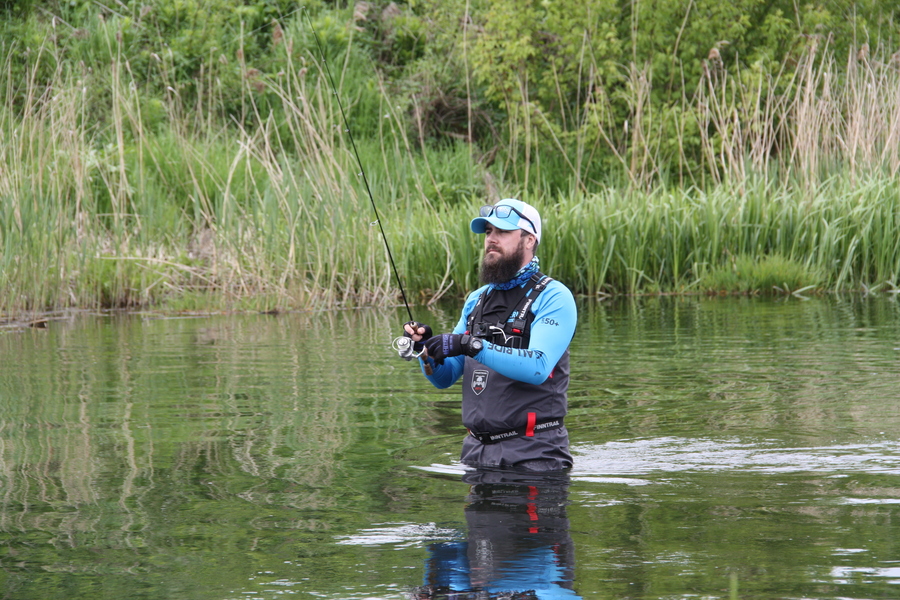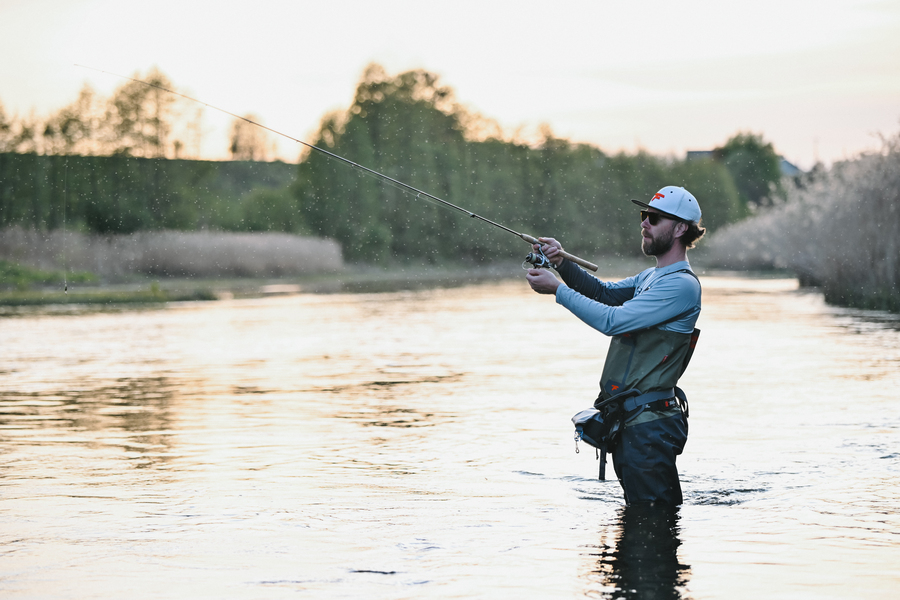The Complete Guide to Fishing in Streams
The lure of fishing in streams isn’t just about catching fish — it’s about exploration, solitude, and uncovering untapped waters rich with life. Whether you're new to fishing in a stream or you're chasing wild brookies deep in the woods, learning how to find and fish a stream of your own is a deeply rewarding skill.
This guide will teach you how to locate hidden water, understand fish that live in rivers and streams, and master fishing techniques — especially for fishing in small streams — so you can create your own angling adventures, season after season.

Step 1: How to Find Your Own Stream
A. Blue Lining: Reading Maps for Water
One of the most effective ways to find a stream is by using topographic maps and satellite imagery. This method, often called blue lining, refers to locating small, unnamed creeks and feeder streams on maps by looking for blue lines — indicators of water bodies.
Tips for finding streams using maps:
-
Use Google Earth, Gaia GPS, or OnX Hunt.
-
Look for tributaries off known trout rivers.
-
Follow elevation lines to locate valleys, springs, and coldwater pockets.
-
Pay attention to public land overlays — national forests are a goldmine.
B. Tap Local Knowledge
Local fishing apparel and gear shops, online forums, and state fisheries websites can provide insider tips. In Reddit’s fly fishing community, anglers frequently share advice on finding productive small waters, often recommending scouting forest roads, hiking back trails, and fishing areas upstream of stocked sections for wild fish.
C. Scout Small Tributaries and Feeder Creeks
Fish often migrate into tributaries to feed and spawn. These feeder creeks may only be a few feet wide, but can hold surprising numbers of fish in the right season.
Step 2: Understand the Fish in Streams
A. Common Fish Found in Streams
Whether you’re exploring a clear mountain stream in the Alps, a woodland brook in the British Isles, or a meandering river in Central or Eastern Europe, freshwater streams are home to a diverse array of fish species:
Brown Trout
One of Europe’s most iconic stream fish, brown trout are native to many parts of the continent and thrive in cool, oxygen-rich waters. They’re often found in shaded, fast-flowing streams, hiding beneath overhanging banks, boulders, or submerged wood.
Atlantic Salmon
In streams connected to the sea, especially in Scandinavia and the British Isles, juvenile Atlantic salmon can often be found. These young salmon inhabit clear, well-oxygenated headwaters before migrating downstream to the ocean.
Grayling
Known for their sail-like dorsal fin and delicate beauty, grayling prefer cold, clean rivers and streams with gravel bottoms. Common in Central and Eastern Europe, they’re highly sensitive to pollution, making them a good indicator of stream health.
European Chub
A widespread and adaptable species, chub are often seen in medium to large streams and rivers. They tolerate a wide range of conditions and feed on insects, small fish, and plant material. Larger chub are often found in deeper pools and under overhanging vegetation.
Minnows, Gudgeon, and Dace
These small schooling fish are common in streams and are an essential part of the aquatic food chain. They often inhabit shallow riffles and calm pools, providing a vital food source for larger predatory fish such as trout and perch.

B. Seasonal Behavior
Fish in streams respond strongly to seasonal changes in water temperature, flow, and food availability. Understanding their behavior throughout the year can improve your fishing success and deepen your appreciation for stream ecology.
Spring
As water temperatures begin to rise and snowmelt increases stream flow, fish become more active. Insect hatches such as mayflies, caddisflies, and stoneflies emerge in abundance, providing a rich food source. Trout and grayling move into shallower riffles to feed, while chub and dace often patrol slower margins and pools. It’s one of the best seasons for fly fishing.
Summer
In summer, stream temperatures rise and water levels typically drop. Fish seek cooler, oxygen-rich refuges — often deeper pools, shaded undercut banks, or areas with faster currents. Brown trout become more nocturnal, feeding in the early morning and late evening. In southern and lower-elevation streams, species like chub and barbel become more dominant.
Autumn
With cooling temperatures and increased rainfall, fish become active again. Brown trout and salmon begin their spawning runs, moving upstream and becoming more territorial. Grayling, which spawn in spring, feed aggressively in preparation for winter. Autumn is a dynamic time, with changing foliage and active fish.
Winter
Cold water slows down fish metabolism significantly. Trout and grayling often settle into deeper pools where they conserve energy and feed only sporadically. Activity is reduced, but on milder days, some midwinter insect activity may still tempt a few fish to rise. Fishing is more technical, requiring a slower presentation and careful observation.
Step 3: Master Fishing in Small Streams
Fishing in small streams requires stealth, strategy, and smart fly selection.
A. Dry Fly Fishing
When hatches are on, dry flies can be incredibly productive in small streams.
-
Best Patterns: Parachute Adams, Elk Hair Caddis, Royal Wulff
-
Technique: Cast upstream from a crouched position, using short drifts and light tippets.
-
Target: Foam lines, riffles, tailouts
B. How to Fish Nymphs
Subsurface insects make up most of a trout’s diet, and knowing how to fish nymphs in small streams is key.
-
Rigs: Tight-line nymphing (Euro style) or dry-dropper setups
-
Patterns: Pheasant Tail, Hares Ear, Prince Nymph, Perdigon
-
Presentation: Short drifts through riffles, seams, and plunge pools
Tip: Use tungsten-beaded nymphs to sink fast in narrow, fast-moving water.
C. How to Fish Predators
Larger fish are often meat eaters — even in tiny water. Fishing streamers help cover water quickly and target territorial fish.
-
Patterns: Woolly Bugger, Mini Zoo Cougar, Sculpzilla, Kreelex
-
Approach: Cast upstream or across and strip quickly. Focus on undercut banks and log jams.
Pro Tip: Smaller streamers (1–2 inches) can be more effective than big flies in tight quarters.
Step 4: Essential Gear for Fishing in Streams
Fishing in streams doesn’t require heavy gear. In fact, ultralight setups are ideal.
Recommended Setup:
-
Rod: 6.5'–8.5' fly rod, 2–4 weight
-
Reel: Lightweight, disc-drag optional
-
Line: Weight-forward floating line
-
Leader: 7.5–9' tapered, with 4X–6X tippet
-
Footwear: Sticky rubber or felt boots
-
Accessories: Hemostats, fly floatant, net, and polarized glasses
Step 5: Mindset and Tactics for Success
Fishing in streams is as much about mindset as gear or skill.
-
Be stealthy: Fish are easily spooked in small water.
-
Stay low: Kneel, hide behind rocks, and use the stream bank as cover.
-
Fish upstream: You’ll stay out of sight and present your fly naturally.
-
Explore: Hike further, bushwhack a bit, and you’ll find fish others miss.
Streamside Ethics and Conservation
Respecting the Resource
Small streams are delicate ecosystems that offer unique fishing experiences, often in pristine natural settings. To ensure these waters remain healthy and accessible for future generations, anglers have a responsibility to fish thoughtfully and minimize their impact on the environment.
Catch and Release
When fishing in small streams—especially those home to native or wild fish populations—practicing catch and release is crucial. These fish often exist in limited numbers and are sensitive to pressure. Use barbless hooks, handle fish gently with wet hands, and release them quickly to maximize their chances of survival. Protecting breeding populations helps preserve the genetic diversity and resilience of these local fish.
Leave No Trace
Always pack out everything you bring in, including fishing line, bait containers, food wrappers, and any other waste. Small stream environments are often remote and fragile—trash left behind can harm wildlife, pollute water sources, and ruin the natural beauty for others. Stay on established trails, avoid trampling vegetation near the banks, and leave the area as undisturbed as you found it.
Clean Your Gear
Aquatic invasive species like algae, parasites, and small invertebrates can be easily transported on boots, waders, nets, and even rod cases. Thoroughly clean and dry your gear before moving to a different waterway. This simple step helps prevent the spread of harmful species that can devastate local ecosystems and outcompete native fish.
Respect Private Property
Many of the best small streams flow through private land. Accessing them without permission is not only illegal but can also lead to landowners restricting access to everyone. Always ask for permission when approaching private land, and use designated public access points whenever available. Being courteous and respectful helps maintain good relationships between anglers and landowners.
Final Thoughts: Find Your Flow
Fishing in small streams is about more than numbers — it’s about discovering wild places, reading water with intuition, and learning the language of fish that live in rivers and streams.
Whether you're stalking wild brookies with dry flies or swinging streamers through a dark pool under overhanging cedar, your own stream is out there — waiting for you to find it.





